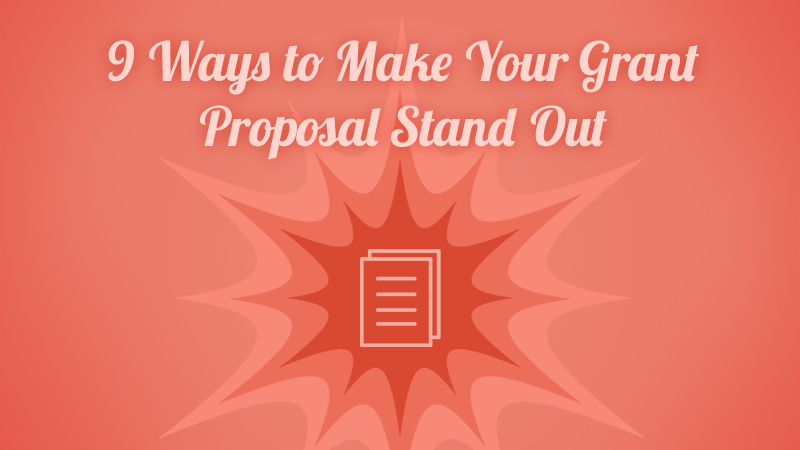9 Ways to Make Your Grant Proposal Stand Out

Grant proposals can stand out for any number of reasons. In some cases, it’s because they’re missing two attachments, or they’re trying to fit a square peg into a round hole. Or sometimes, they’ve buried the mission statement somewhere in a blizzard of text. Below, we’ve included tips to stand out—for all the right reasons.
1) Do your research. Make sure you really get to know a foundation—and beyond the surface level summary of program interests. Thoroughly review their materials (website, annual reports, even 990s) to see more specifically what kind of programs they’ve funded. This is significant. Don’t rely solely on a research database, either—look for multiple sources, such as a foundation’s website or a recent 990, to make sure you have the most recent information.
2) Make a good match. Read all the details and be ready to sniff out the no, instead of trying to stretch for a yes. Don’t waste your time on proposals that aren’t a good fit; don’t try to dress a general operating or capital grant in a program grant’s clothing. Spend your time finding and targeting proposals where you clearly tick every box, and tailor your proposals to the specific foundation, as much as possible.
3) Don’t be a stranger. If possible, contact the foundation—after you’ve done your research—with specific questions or uncertainties about their focus area, criteria, guidelines, and/or whether your organization is truly a fit. Try to demonstrate that you have done your research, and that you aren’t asking questions that are readily available on their website or other online materials. Even better, work to develop a relationship with the foundation before applying; beyond a phone call or two, look for connections to the foundation among your staff or board.
4) Make a good first impression. The cover letter is your first chance to stand out and get the funder’s attention. It’s a good place to reference any personal contact you’ve had with them. It can also be a good place to add a little touch that shines—perhaps a memorable quote that reflects your work, or a brief anecdote about a program recipient, or a photo of a program in action. Such a detail can be a strong way to draw the funder in and ground the proposal from the very beginning in the impact of your work.
5) Watch your language. Don’t assume the reader knows anything about your subject area. Explain your work clearly and thoroughly—but don’t get lost in the weeds with too much detail or technical language. Be concise, be concrete, and avoid jargon. Also take time to get clear about what each section of the proposal is driving at and take care to avoid repetition between sections.
6) Be a good tour guide. Make it easy for the reviewer to find their way through your document. Avoid long, uninterrupted paragraphs. Don’t make a reviewer hunt for your mission statement. Use elements that can be easily skimmed—clear, consistent headings and subheadings, and bulleted or numbered lists for things like goals and objectives. Choose a basic and easy-to-read typeface that is 11- or 12-point font (unless the foundation specifies), and leave sufficient white space—at least 1” all around. Include visual aids such as graphs or photos, if the proposal format allows.
7) Paint a picture, tell a story. The Need/Opportunity and Outcome/Impact sections are prime real estate for painting a picture of your work. Be specific—use concrete details (think of the five senses) and descriptive language, perhaps telling a brief story or profiling a beneficiary. Wherever the proposal addresses evaluation, be sure to use specific, quantifiable metrics to further illustrate what specifically will change as a result of your work.
8) Follow the directions.Grantmakers are often very particular about how they want to receive information; surely this helps review a big stack or queue of applications, allowing them to more quickly process each packet and verify its completeness. Follow each and every instruction to ensure your proposal isn’t dismissed before it’s considered. Double check things like font size, word count, double-sided copies, staples, and attachments to include or avoid. Don’t include attachments they don’t ask for; it won’t make you proposal stand out in a good way. Directions also apply to things like how to contact a foundation; honor their preferred method of contact, whether a phone call, email, or full proposal.
9) Remember the follow-up.Your follow-up starts the minute you get the grant. Don’t celebrate and then stuff the grant agreement in a drawer. Of course there’s the thank-you letter to send, and a signed grant agreement. But these grant agreements aren’t like the user agreements we quickly sign online; they have vital instructions. Review carefully for expectations, reporting guidelines, deadlines, etc., and be sure to inform program staff of the metrics and other elements the foundation will be expecting in a year (or sooner). Add the reporting dates to your grant calendar, and give yourself—and your program staff—plenty of time to put together the report. Create a knock-out report—with the same concrete details, illustrative anecdotes, clear metrics, and well-answered questions, to stand out yet again.
Article by: Kate Lucas, Library Strategies Consultant & Grant Writer

